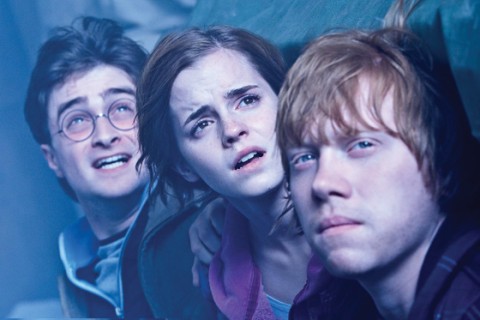Harry Potter and the Deathly Hallows–Part 2

There's never been anything quite like the Harry Potter movies—a film series that overlapped with the septet of novels on which it's based, reaching the midpoint of the narrative a year before its creator, J. K. Rowling, put out the last book and then spinning out the movie arc for another five years. The finale, Deathly Hallows, Part 2, is all one might hope.
Director David Yates and screenwriter Steve Kloves assume that viewers are familiar with the most intricate narrative details and don't need to start by being caught up. So the movie hits the ground running, with Harry and his friends at a safe house, trying to work out a way to destroy the Horcruxes that contain fragments of the soul of Lord Voldemort (Ralph Fiennes) and thus shore up his power. Back at Hogwarts, the students and professors are under the thumb of Voldemort's cruel minions. We see images of fascism: the students march in the courtyard while spectral Dementors hover ominously above the school. The world has fallen into darkness, and as Harry, Hermione and Ron (Daniel Radcliffe, Emma Watson and Rupert Grint) return to Hogwarts to lead the resistance, the imagery takes on a Götterdämmerung-like splendor.
The film's themes, welling up from the last three episodes, are coming of age, camaraderie, the link between past and present and the complex nature of loss—its power to strengthen as well as to provide a source of inspiration and understanding. Before Harry faces Voldemort in battle, he communes with the spirits of his dead, including the father and mother who died to save his life when he was a baby. "I never meant any of you to die for me," Harry protests softly. This scene makes explicit the idea on which much of the story is premised: that those who love Harry continue to stand with him even in death. (It's especially affecting to see again Sirius Black, Harry's godfather, played by Gary Oldman in flowing Byronic locks.)
Harry even communes with his mentor, the late Hogwarts headmaster Albus Dumbledore (Michael Gambon), in a gorgeous sequence laid in a dreamlike version of a train station. At the end of their conversation, the headmaster tells Harry that while the exchange took place in Harry's head, that doesn't mean it isn't real. The comment is a reminder of how we keep the ones we love inside us and draw on them in times of crisis. Love is the power that the movie offers up against fear, and as the story unfolds the smashing of the Horcruxes becomes a metaphor for Voldemort's decreasing ability to rule through fear. This notion is perhaps clearest in the behavior of Narcissa Malfoy (Helen McCrory), whose love for her son Draco (Tom Felton) eventually transcends her fear of the dark lord and scrambles her allegiances.
The climax is a little confusing; Kloves cuts a plot point or two that might have clarified it. He and Yates seem determined to pare down the focus of the last battle—to boil it down to the struggle between Harry and Voldemort and to the triumvirate of Harry, Hermione and Ron. Even the most significant of the adults have always been supporting players in the Harry Potter stories. Like all great fairy tales, they're about how children navigate the frightening world bequeathed to them by adults.





